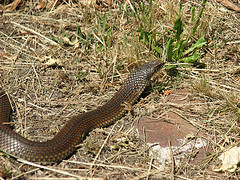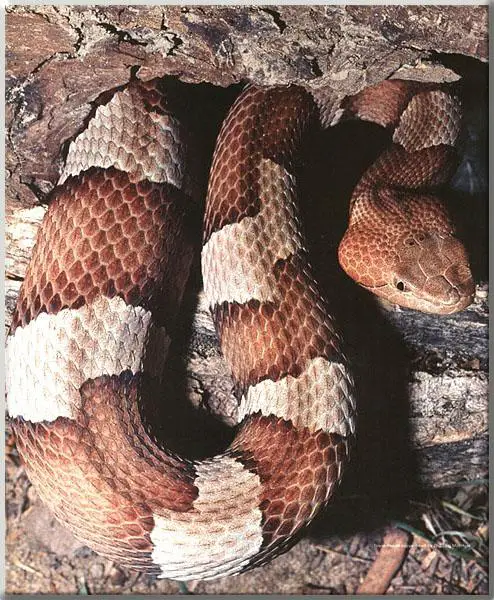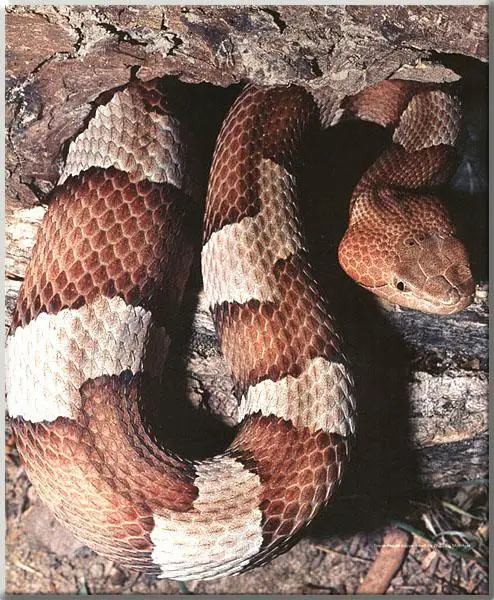Agkistrodon contortrix is a species of venomous snake found in North America, a member of the Crotalinae (pit viper) subfamily. Common names for the species include Copperhead and moccasin.
Adults usually grow to a total length of 50-95 cm, although some may exceed 1 m. Males are usually larger than females. The maximum length reported for this species is 134.6 cm. Brimley 1944 mentions a specimen of A. C. Mokasen from Chapel Hill, North Carolina, that was 137.2 cm, but this may have been an approximation.
The body is relatively stout and the head is broad and distinct from the neck. Because the snout slopes down and back, it appears less blunt than that of the cottonmouth, A. Piscivorus. Consequently, the top of the head extends further forward than the mouth.
The scalation includes 21-25, usually 23, rows of dorsal scales at mid-body, 138-157 ventral scales in both sexes and 38-62/37-57 subcaudal scales in males/females. The subcaudals are usually single, but the percentage decreases from the northeast, where about 80% are undivided, to the southwest of the geographic range where as little as 50% may be undivided. On the head there are usually 9 large symmetrical plates, 6-10 supralabial scales and 8-13 sublabial scales.
The color pattern consists of a pale tan to pinkish tan ground color that becomes darker towards the midline, overlaid with a series of 10-18 crossbands. Characteristically, both the ground color and crossband pattern are pale in A. C. Contortrix. These crossbands are light tan to pinkish tan to pale brown in the center, but darker towards the edges. They are about 2 scales wide or less at the midline of the back, but expand to a width of 6-10 scales on the sides of the body. They do not extend down to the ventral scales. It is common for the crossbands are divided at the midline and alternate on either side of the body, with some individuals even having more half bands than complete ones. A series of dark brown spots is also present on the flanks, next to the belly, and are largest and darkest in the spaces between the crossbands. The belly is the same color as the ground color, but may be a little whitish in part. At the base of the tail there are 1-3 brown crossbands followed by a gray area.
Adults usually grow to a total length of 50-95 cm, although some may exceed 1 m. Males are usually larger than females. The maximum length reported for this species is 134.6 cm. Brimley 1944 mentions a specimen of A. C. Mokasen from Chapel Hill, North Carolina, that was 137.2 cm, but this may have been an approximation.
The body is relatively stout and the head is broad and distinct from the neck. Because the snout slopes down and back, it appears less blunt than that of the cottonmouth, A. Piscivorus. Consequently, the top of the head extends further forward than the mouth.
The scalation includes 21-25, usually 23, rows of dorsal scales at mid-body, 138-157 ventral scales in both sexes and 38-62/37-57 subcaudal scales in males/females. The subcaudals are usually single, but the percentage decreases from the northeast, where about 80% are undivided, to the southwest of the geographic range where as little as 50% may be undivided. On the head there are usually 9 large symmetrical plates, 6-10 supralabial scales and 8-13 sublabial scales.
The color pattern consists of a pale tan to pinkish tan ground color that becomes darker towards the midline, overlaid with a series of 10-18 crossbands. Characteristically, both the ground color and crossband pattern are pale in A. C. Contortrix. These crossbands are light tan to pinkish tan to pale brown in the center, but darker towards the edges. They are about 2 scales wide or less at the midline of the back, but expand to a width of 6-10 scales on the sides of the body. They do not extend down to the ventral scales. It is common for the crossbands are divided at the midline and alternate on either side of the body, with some individuals even having more half bands than complete ones. A series of dark brown spots is also present on the flanks, next to the belly, and are largest and darkest in the spaces between the crossbands. The belly is the same color as the ground color, but may be a little whitish in part. At the base of the tail there are 1-3 brown crossbands followed by a gray area.



